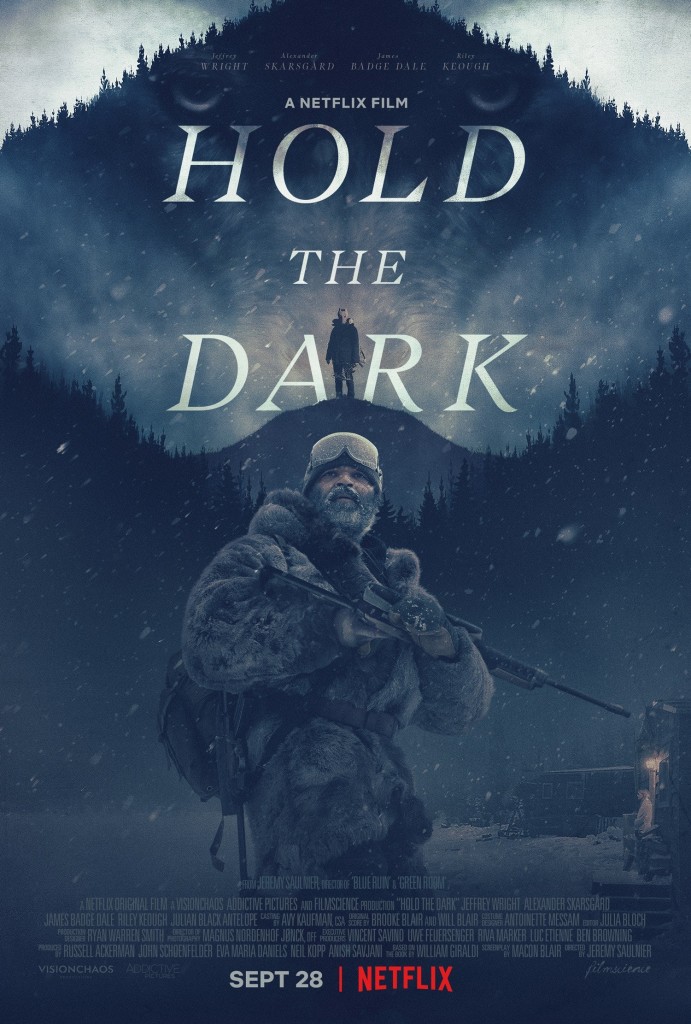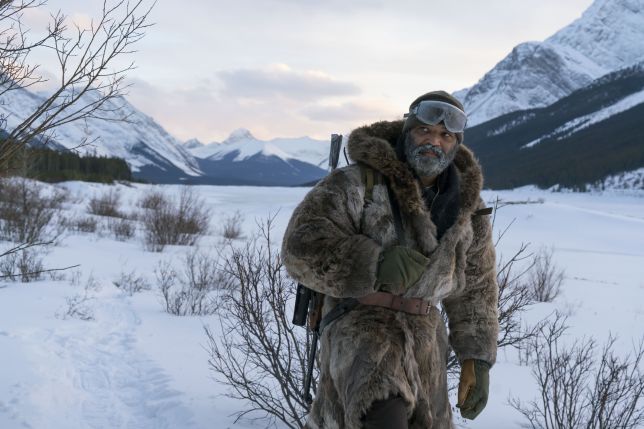Genre: Drama
Premise: After a young child is taken and killed by a wolf, an Alaskan woman hires a wolf expert to find and terminate the offending wolf.
About: It’s the newest Netflix Original release. But don’t let that scare you off. This one is supposed to be good. It stars Big Little Lies standout, Alexander Skarsgård, and Westworld mainstay, Jeffrey Wright. It’s directed by Green Room director Jeremy Saunier and written by Macon Blair, an actor friend of Saunier’s who appeared in three of his films.
Writer: Macon Blair (based on the novel by William Giraldi)
Details: 125 minutes long
Some people consider Jeremy Saunier the best kept secret in Hollywood. His second movie, Blue Ruin, became an out-of-nowhere Rotten Tomatoes success with a 95% rating. The movie didn’t have a single known actor in it. The next film in his color-coded dualogy, Green Room, starring Anton Yelchin and Patrick Stewart, became a cult sensation, garnering similar critical praise. This adoration helped Saunier land a two-episode gig on the latest season of True Detective. And I’m sure it’s only a matter of time before Saunier gets offered a DC property, if he hasn’t already.
One of the reasons I was so eager to check Hold the Dark out was because the jury was still out for me on Saunier. I found Blue Ruin to be overly bleak. And Green Room, while interesting, was a genre mish-mash. I was never quite sure what I was watching. With that said, we need a strong new voice in the directing game. The ranks are getting stale. Not to mention, I’m excited by the fact that Netflix may have, for once, produced a good movie.
Writer, wolf-expert, and highly depressive Russell Core, flies to an isolated Alaskan town to meet a woman who claims that a wolf killed her child. She wants him to find and kill the wolf for which she’ll pay him handsomely. But Core gets the sense – along with us – that something’s off about the woman. She hasn’t even alerted her husband, who’s off fighting in Iraq, that their son is dead.
After hunting down the offending wolves (which amounts to a 5 minute walk to the nearby forest), Core gets cold feet and heads back to the mother’s house, where he learns she has fled. He heads downstairs into the basement, where he finds her dead son, rolled up in plastic. It turns out he wasn’t killed by wolves after all.
Meanwhile the boy’s father, Vernon, comes back from Iraq and is none too happy to find out his boy is dead, his wife is gone, and some big city wolf expert was staying at his place. So mad, in fact, that he shoots two local cops. The deaths are a precursor to a string of killings that include the coroner who dealt with the boy and the local witch doctor.
When the cops come asking Vernon’s best friend if he knows anything about the killings, the friend goes upstairs, rigs up a gatling gun, and starts gunning down everyone within a 2000 foot radius. Core is nearby, watching all of this go down. But if I’m being honest, I have no idea what his role in the story is at this point. Eventually they kill the friend in a dramatic shootout where he falls from his perch spread eagle in slow motion, a shot so poetic I’m convinced it’s the only reason they included the scene in the first place.
From there, we intercut between Core, the local sheriff, and Vernon, who seems to be on some side-mission to kill every friend of his. I think the rest of the movie is about Core and the sheriff looking for the missing mom, but you’d have to strap Saunier and Blair to a polygraph test to know for sure. The further on this disaster goes, the less sense it makes.
Oh man.
I’ve seen some brutally bad movies this year. But this is a special kind of bad. It’s the kind where the filmmaking and acting are so good that you can’t logically comprehend why the writing, then, is so awful.
What’s so funny to me is that 20 years ago, the big rah-rah talking point in Hollywood was, “Imagine how good movies would be if there was no studio interference. If those guys in the suits would just get their bean-counting hands away from the creative folk and let the writers do their jobs, we’d only have great movies from here til the end of time.”
Well now we’re seeing that exact scenario play out. This is how Netflix and Amazon are luring talent to the less glitzy world of streaming video. “We’ll let you do whatever you want. Not a single note.”
If you don’t have smart development people calling you on your shit, you’re going to create shit. And this script is full of shit. It’s a mish-mash of nonsense that never picks a lane. Is it a movie about revenge? Is it a murder investigation? Is it a character study? Is it a war movie? Is it a serial killer flick? Is it an action film? Is it about PTSD? Is is about a small town pushing away big city outsiders? Is it a horror flick?
Hold the Dark tries to be all of these things and becomes a giant bag of screenwriting compost in the process.
I’ll tell you exactly when I knew this script had no hope. It didn’t take long actually. In an early scene, Core is sleeping at the mother’s house. Why is he sleeping in a strange woman’s house when there’s a motel nearby? Who knows. Anyway, he wakes up in the middle of the night to see the woman, completely naked, standing in the middle of the room, wearing a mask. She then takes off the mask, slides next to him, makes him choke her for a minute, then goes to sleep.
My head fell, my eyes closed, I shook my head. This is the kind of garbage idea beginner writers pull all the time because they don’t know what drama is. They don’t know what suspense is. They don’t understand conflict. They don’t know that characters need logical motivations to dictate their actions. They don’t even know that a scene needs a plan. Why do the hard work when you can scrap together a flashy image that’ll look good for two seconds despite the fact that it has nothing to do with anything?
I was like, “Yup. Guaranteed the rest of this movie is going to be trash.” And it was. The main character keeps shifting (it’s Core, no it’s the local Sheriff, no it’s Vernon), which is fine if your name is Quentin Tarantino. Not so much if you’re Johnny First Screenplay. We’ve got classic beginner mistakes like random flashbacks thrown in at arbitrary intervals. We introduce brand new characters halfway into the script. And the plot – oh the plot. It was as if they let the location scout direct the film. They had all these places to shoot but no script to tie them together. So they said, “Let’s shoot them all and figure it out later!”
Also, the script is so steeped in bleakness that it becomes impossible for us to emotionally invest in what’s happening. Classic beginner mistake. If you only hit one emotional beat the whole time, your audience becomes numb. They need a range of emotions so they have something to compare and contrast said emotions to. There’s an old saying that you want to take your audience on an emotional roller coaster. If the same tone is hit every scene, you’re not on a roller coaster, you’re on a road.
So we’re right back where we started folks. I’m glad that Netflix is giving people jobs. I really am. It’s hard to find screenwriting money outside of television these days. But if these guys want to be taken seriously in the feature world, they need to revamp that entire department. This movie is garbage. There’s not a single thing about it that makes sense and, in large part, that’s due to the lack of oversight. And the reason I know there was no oversight is because even a first year script reader could’ve identified and helped clean up some of these mistakes.
[x] What the hell did I just watch?
[ ] wasn’t for me
[ ] worth the time
[ ] impressive
[ ] genius
What I learned: The other day we talked about the importance of understanding the 3-Act Structure. Hold the Dark is an example of what happens when you don’t know what the 3-Act Structure is. This movie follows no outline. It has no plan. It goes wherever it wants whenever it wants. And the results of that writing style are here on display to study. Watch this. Feel the frustration. Let it inspire you to learn the proper way to tell a story.



